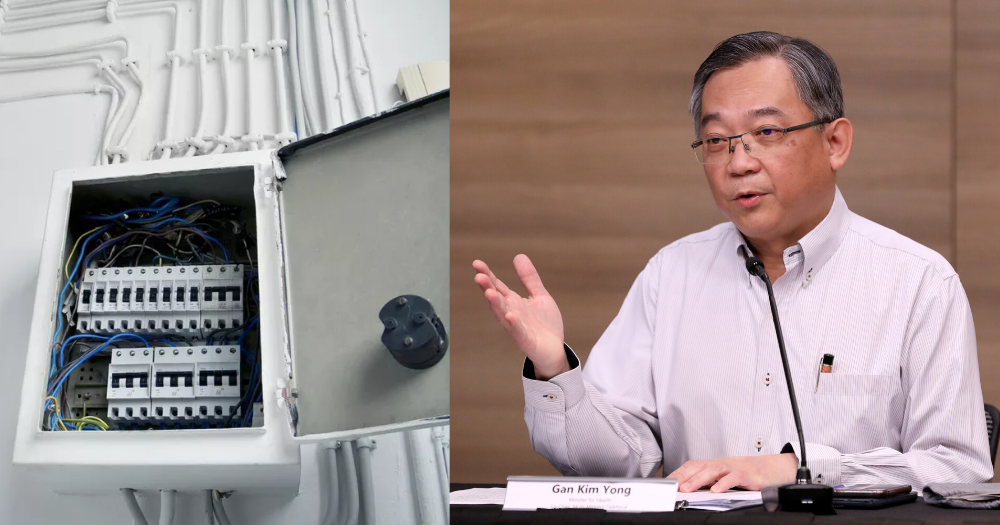Similar to how switches need to turned on one by one after an electrical power trip, Singapore also needs to reopen its economy and society slowly and gradually, said Minister for Health Gan Kim Yong on Tuesday (May 19).
This analogy was shared by Gan during the question and answer portion of the Multi-Ministry Task Force on Covid-19 press conference, during which the government announced its next steps after Singapore's circuit breaker ends on Jun. 1.
Electrical circuit breaker analogy
"Well, circuit breaker is actually exactly like a circuit breaker," Gan explained.
Gan shared his analogy to illustrate the importance of being careful in easing up on circuit breaker measures after the circuit breaker period ends.
"I'm an electrical engineer, so I can explain this," Gan said. "I try to explain this the engineering way."'
He summarised how circuit boards work:
"So, if you have a circuit breaker at home, you know how to operate it — when something goes wrong in the electrical system, the circuit breaker will trip. And you have to turn off the circuit breaker, so that, to cut off the trip.
At the same time, you'll turn off everything and you'll turn back on the circuit breaker, and slowly, one by one, you turn on the switches and see which one trips again.
And the one that trips again is the one that is at fault. So that's the concept of circuit breaker."
Similarly, he said, the Covid-19 circuit breaker was applied in order to cut off almost everything, as we dealt with a pandemic outbreak.
Must be careful as we turn on the "power supply" again
Continuing with his analogy, then, Gan explained that now that we are "turning on the power supply again" by removing the circuit breaker, we cannot turn on all the switches at once.
"If you turn on all the switches at the same time, for sure it's going to trip again. So therefore we have to be very careful, turn on one by one, slowly, gradually.
And we need to continue to observe and monitor as we turn them on, because as we turn them on, if there's a trip again, then you know where the problem is."
In the case of Singapore's reopening of society, turning on the switches one by one means restoring some services and activities slowly.
Identifying which switch causes the trip is the equivalent of observing to see which particular activity is likely to create a problem, Gan said.
And once that activity has been identified, he said, then targeted measures may need to be introduced to solve the problem.
Timeline for Phases 1, 2, and 3
It was announced on May 19 that Singapore will be reopening in three phases:
- Phase 1: Safe Re-opening
- Phase 2: Safe Transition
- Phase 3: Safe Nation
During the question and answer session, Gan also fielded a question on how long each phase might last.
"This is a very difficult question," he responded. "Because we don't have a crystal ball to see what's going to happen."
For Phase 1, Gan said, the government will need to first observe at least two periods of incubation, or four weeks. Therefore, it is unlikely that the phase will last less than four to six weeks, and depending on how the situation evolves, it may be longer.
Phase 2, he explained, is a transition phase. The transition phase involves multiple steps, such as relaxing some measures earlier while some measures may need to continue.
Minister for National Development Lawrence Wong added that the transition at the beginning of Phase 2 will start with lower-risk activities.
He shared examples of lower-risk activities that the government will consider — limited social activities — such as people gathering in small groups, dining in, retail shops opening, and the opening of sport facilities.
Higher-risk activities, such as events, entertainment, and attractions, which can attract crowds and cause more close contact, Wong said, would be assessed in the later part of Phase 2.
The period of time for Phase 2 is uncertain, Gan stated, but will involve months, not just weeks:
"It may take three months, six months, depends. It may take longer, depending on how the situation evolves."
And at the end of Phase 2, said Gan, Singapore will "naturally arrive" at Phase 3.
No time limit for Phase 3
Phase 3 will be a "steady state" and a "sustainable situation where we are able to make Singapore safe", although there will be some measures that continue to be in place.
Gan said that Phase 3 can be expected to be long-term, perhaps extending until vaccines become available or a cure is found, or after the disease is no longer threatening.
Thus, Gan said, Phase 3 does not have a time limit.
"And therefore, going forward, as we roll out our phase one, phase two, and phase three roadmap, we need to continue to monitor," Gan stated.
"Phase 3 is not a return to life before Covid-19," said Wong. "In Phase 3, we envisage that many of the things that we are used to can continue, but there will be new controls safeguards and limits."
Top photos via MCI and Getty Images.
If you like what you read, follow us on Facebook, Instagram, Twitter and Telegram to get the latest updates.
